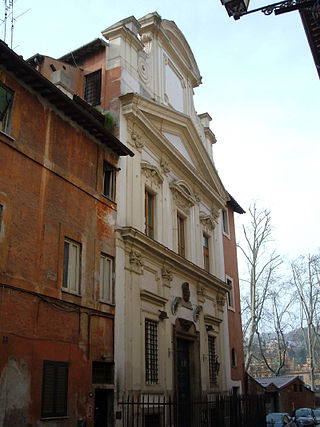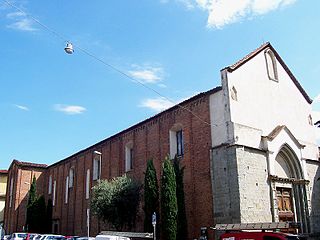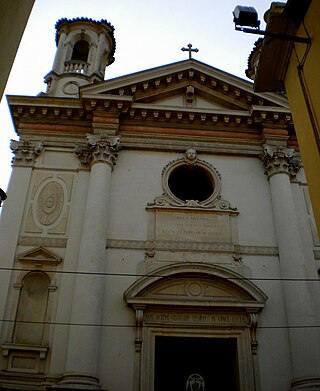An oratorio is a musical composition with dramatic or narrative text for choir, soloists and orchestra or other ensemble.
(Gian) Giacomo Carissimi was an Italian composer and music teacher. He is one of the most celebrated masters of the early Baroque or, more accurately, the Roman School of music. Carissimi established the characteristic features of the Latin oratorio and was a prolific composer of masses, motets, and cantatas. He was highly influential in musical developments in northern European countries through his pupils, like Kerll in Germany and Charpentier in France, and the wide dissemination of his music.

Trevi is the 2nd rione of Rome, Italy, identified by the initials R. II, located in Municipio I. The origin of its name is not clear, but the most accepted theory is that it comes from the Latin trivium, because there were three streets all leading to the current Piazza dei Crociferi, a square next to the modern Trevi square. Its coat of arms is made of three swords on a red background.

There are more than 900 churches in Rome, which makes it the city with the largest number of churches in the world. Almost all of these are Catholic.

San Marcello al Corso, a church in Rome, Italy, is a cardinalitial titular church whose cardinal-protector is normally of the order of cardinal priests.

The Via del Corso is a main street in the historical centre of Rome. It is straight in an area otherwise characterized by narrow meandering alleys and small piazzas. Considered a wide street in ancient times, the Corso is approximately 10 metres wide, and it only has room for two lanes of traffic and two narrow sidewalks. The northern portion of the street is a pedestrian area. The length of the street is roughly 1.5 kilometres.

The Church of the Most Holy Name of Mary at the Trajan Forum is a Roman Catholic church in Rome, Italy. This church should not be confused with the church Santissimo Nome di Maria in Via Latina in south-east Rome.

Santi Angeli Custodi, church on Via Alpi Apuane, Rome.

Cristoforo Roncalli was an Italian mannerist painter. He was one of the three painters known as Pomarancio or Il Pomarancio.

The Oratorio del Gonfalone or Oratory of the Banner is a building in Central Rome which once housed a Catholic fraternity. Since about 1960 it has served as a concert venue for the Roman Polyphonic Choir.

Cesare Nebbia (c.1536–c.1614) was an Italian Mannerist painter from Orvieto.

Santo Stefano de Pinea or more commonly Santo Stefano del Cacco is a church in Rome dedicated to Saint Stephen, located at Via di Santo Stefano del Cacco 26.
San Bernardo della Compagnia was a small church in Rome, next to Trajan's Column, dedicated to Saint Bernard and the Virgin Mary.
Quirino Colombani was an Italian composer, and cellist. He was active in both 17th and 18th centuries.

The Oratory of San Francesco Saverio del Caravita is a 17th-century baroque oratory in Rome, near the Church of Sant’Ignazio in rione Pigna. It is home to the Caravita Community, an international English-language Catholic community in Rome.

San Domenico is a Romanesque and Gothic-style, Roman Catholic church located in the Piazza of the same name, with a north flank of the nave parallel to Corso Silvani Fedi, in Pistoia, region of Tuscany, Italy.

Santa Croce is a Roman Catholic church located on Corso Vittorio Emanuele 178 in Padua, Veneto region, Italy.

The Chiesa del Santissimo Crocifisso e Anime Sante del Purgatorio, known in general as the Chiesa del Purgatorio, is a neoclassical-style, Roman Catholic church located on Strada Gesù #20 in Castellammare di Stabia, in the metropolitan city of Naples, region of Campania, Italy.

Santissimo Crocifisso is a Catholic church in Alcamo, in the province of Trapani, Sicily, southern Italy.

The crucifix of San Marcello is a medieval work of religious art that is venerated in the Oratory of Santissimo Crocifisso of the Church of San Marcello al Corso in Rome. Having survived a fire that destroyed the church in 1519, the crucifix was popularly believed to possess intercessory powers. During an epidemic of plague in 1522 the crucifix was carried in a procession through the city. According to popular belief at the time, the procession caused the plague to leave the neighborhoods through which the crucifix passed, and eventually to die out in Rome.



















